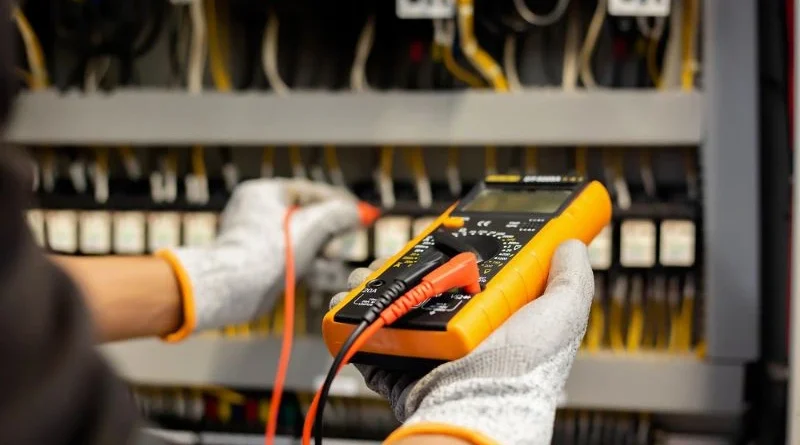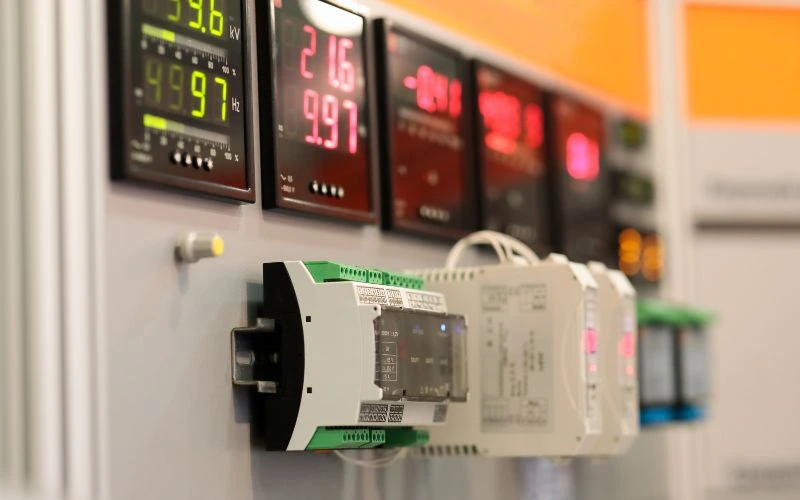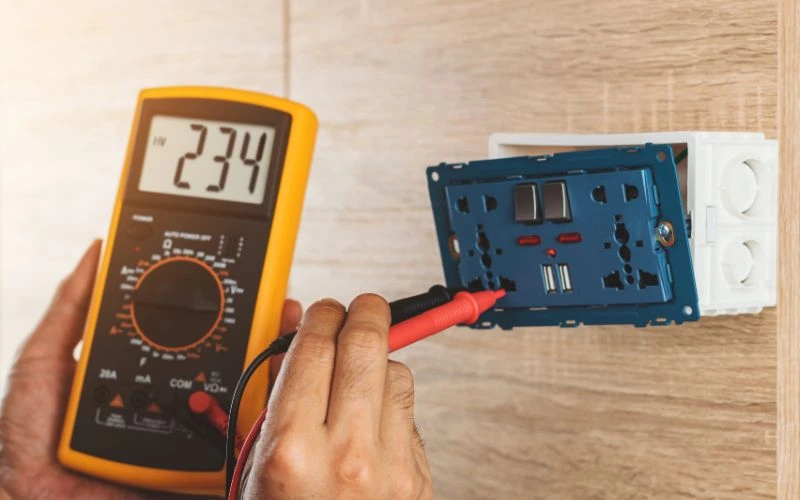
Imagine being able to unlock the hidden language of electronics, decipher its complex vibration and make it dance to your music! Welcome to the exciting world of electrical engineering, where understanding the relationship between current and voltage is crucial. This comprehensive guide delves into Ohm's Law and aims to simplify these abstract concepts so that you are able to understand, create, or troubleshoot any electronic circuit at a fundamental level. So let's go ahead and light up your knowledge lamps as we travel the exciting paths of electrical currents and voltages.
Voltage measures the electrical potential energy per unit charge in a circuit, while current is the rate of flow of electrical charge in a circuit. Voltage is measured in volts (V), while current is usually measured in amps (A). Without voltage there can be no current, but just because there is voltage doesn't mean current is flowing. Understanding these concepts is fundamental for anyone working or studying electrical engineering or related areas.
Voltage and current information

To understand the fundamentals of electrical engineering, it is important to understand the concepts of voltage and current. They are the building blocks on which many electrical principles are based.
Voltage can be considered the driving force behind electrical flow in a circuit. Represents the potential difference between two points, measured in volts (V). Voltage can be compared to pressure in a water pipe, where high voltage corresponds to high pressure and low voltage corresponds to low pressure. The higher the voltage, the more energy is available to pump electrical charge through the circuit.
Current, on the other hand, is the flow of electrical charge within a circuit. It represents the speed at which electrons pass through a point in a conductor and is measured in amperes (A). Electricity can be thought of as the amount of water that flows through a pipe per unit of time. A higher current means that more charge flows through a specific point in the circuit.
Difference Between Voltage and Current
Voltage and current are often used interchangeably, but they represent different aspects of electrical systems. In short, voltage is the energy per unit charge, while current is the rate of flow of electrical charge in a circuit at a given point.
An important difference between voltage and current lies in their units of measurement. Voltage is measured in volts (V), while current is measured in amps (A). The voltage across a component or circuit determines how much energy each charge carries, while the current in a circuit determines how many charges pass a given point per second.
Additionally, voltage creates an electrostatic field within a circuit that exerts a force on charged particles, such as electrons, pushing them through the circuit. In contrast, current creates a magnetic field around the conductor through which it flows.
In terms of its behavior within circuits, voltage behaves differently from current in series and parallel circuits. In series circuits, voltage is distributed across all components while the same amount of current flows through all components. In contrast, parallel circuits maintain a constant voltage across all components while distributing their total current.
Electrical engineers can troubleshoot circuit problems effectively if they understand the difference between voltage and current. You can identify whether there are insufficient voltage issues or interruptions in the flow of electrical power that may prevent proper functioning or cause potential damage to electrical devices.
For example, imagine a scenario where a light bulb doesn't turn on. By measuring voltage and current at various points in the circuit, an engineer can determine whether insufficient voltage in the circuit or an open circuit is preventing the lamp from receiving enough current.
Some may wonder why we have to differentiate between voltage and current in electrical engineering. After all, they are related concepts that often go hand in hand. However, understanding their unique properties is essential for accurate system analysis, troubleshooting, and designing efficient electrical systems. This allows engineers to accurately diagnose problems and make informed decisions when selecting components or optimizing circuit performance.
In simple terms, voltage can be compared to the difference in elevation between two points in a water pipe system, while current is analogous to the actual flow of water through that pipe. Just as understanding pressure and flow is fundamental for hydraulic engineers, understanding voltage and current is fundamental for electrical engineering.
Now that we understand voltage and current and their differences, we can examine an essential law that governs them: Ohm's Law.
Introduction to Ohm's Law

In the vast field of electrical engineering, one fundamental principle is the cornerstone for understanding and analyzing electronic circuits: Ohm's law. This law, named after the German physicist Georg Simon Ohm, relates voltage, current and resistance in a circuit. Understanding Ohm's Law allows engineers to accurately and accurately predict and control the behavior of electrical systems.
Essentially, Ohm's law states that the current flowing through a conductor is directly proportional to the voltage across it and inversely proportional to its resistance. In simpler terms, as the voltage increases, the current flowing through the circuit also increases, assuming the resistance remains constant.
Let's imagine an analogy with a water pipe. We can understand how these concepts are related if we consider voltage as the water pressure, current as the water flow rate, and resistance as the pipe diameter. If we increase the water pressure (voltage), more water (current) will flow through the pipe, assuming its diameter (resistance) remains constant.
Ohm's law can be represented mathematically by the equation V = I * R, where V represents the voltage measured in volts (V), I represents the current measured in amps (A) and R represents the resistance measured in ohms (Ω). This equation allows us to manipulate and solve for all variables given the values of the other two.
Engineers often use Ohm's law to analyze circuits and design systems tailored to specific needs. By reformulating the formula, engineers can determine the appropriate resistance value needed for a desired current or calculate how much current would flow through a specific circuit given known voltage and resistance values.
Now that we have laid the foundations of Ohm's law, let us now look at its practical application in everyday electrical engineering.
Practical application of Ohm's law
Ohm's law is used in many areas of electrical engineering, from the design and analysis of electronic circuits to the selection of appropriate components for specific applications. By understanding the relationships between voltage, current and resistance, engineers can solve complex problems and ensure the safe and efficient operation of various devices.
A common practical application of Ohm's law is circuit analysis. Engineers often use the law to determine the current that flows through each component of a circuit by calculating the voltages across various elements and applying corresponding resistance values. With this knowledge, they can identify potential problems or limitations within a circuit and make necessary adjustments accordingly.
Additionally, Ohm's law is used in power calculations. By combining it with other formulas, such as P = VI (power equals voltage times current), engineers can determine the power supplied by the resistive elements in a circuit. This information helps you select the appropriate components and ensures that they can meet performance requirements without overheating or malfunctioning.
Another practical application of Ohm's law is in troubleshooting electrical systems. When unexpected behavior or errors occur in a circuit, engineers can use Ohm's Law to determine possible causes by measuring voltages and currents at specific points. By comparing these measurements to expected values using Ohm's Law principles, engineers can identify faulty components or areas where proper current flow is being hindered.
For example, if an engineer notices a voltage drop across a resistor that exceeds the expected value based on the applied current and resistance, he or she may suspect a problem with the resistor or poor contact between the terminal connections.
By using Ohm's Law as part of their troubleshooting toolkit, electrical engineers can uncover secrets in electrical systems and develop effective solutions.
- It is estimated that 70% of the world's population has access to electricity, which is based entirely on the principles of current and voltage.
- Around 80% of the world's electricity is generated through alternating current systems, for which the concept of voltage and its distinction from electricity is fundamental to its operation.
- A study published in 2021 found that discrepancies in understanding or applying the differences between current and voltage account for approximately 32% of all electrical safety incidents on construction sites.
Tools for measuring voltage and current

To understand electrical circuits, accurately measuring voltage and current is essential. Fortunately, there are specific tools designed for this purpose. Voltmeter and ammeter are the two most important instruments for measuring voltage and current. Let's look at these tools in more detail.
Voltmeter
A voltmeter is a device used to measure voltage, or the difference in electrical potential, between two points in a circuit. Essentially, it provides a numerical value that quantifies the difference in electrical potential between these points. Voltmeters typically have a high resistance, so they do not draw significant current from the circuit that could affect measurement accuracy.
To use a voltmeter, connect it in parallel to the component or part of the circuit whose voltage you want to measure. This allows the voltmeter to accurately measure the potential difference between these two points. The measured voltage is displayed on a numerical scale or on the voltmeter screen, making it easy to read.
ammeter
An ammeter, on the other hand, is a device used to measure the electrical current flowing through a specific point in a circuit. Current is the speed at which an electrical charge passes a specific point. Ammeters are designed so that they do not impede or significantly change the current during measurement.
An ammeter must be connected in series with the component or part of the circuit in which current is to be measured. By passing all the currents through the ammeter, you can accurately read the amount of current flowing through that section of the circuit. Like a voltmeter, ammeters display their readings on numerical scales or screens so they can be easily interpreted.
Now that we know the basics of using voltmeters and ammeters to measure voltage and current, let's examine their importance in electrical engineering and how they contribute to understanding electric fields.
Using voltmeters and ammeters
Voltmeters and ammeters play a crucial role in electrical engineering as they allow engineers and technicians to make accurate measurements of voltage and current. These measurements allow you to analyze circuit behavior, diagnose problems, and make informed decisions about component specifications and performance optimizations.
For example, when designing a circuit, engineers often use voltmeters to ensure that desired voltage levels are present at specific points in the circuit. This allows you to verify that components are operating within the specified voltages, thus avoiding damage or loss of performance.
Ammeters also provide valuable information about the current flow in the different phases of the circuit. They allow engineers to assess whether current is acceptable and ensure efficient operation without exceeding component limits. Engineers can identify potential power losses or bottlenecks in a circuit by accurately measuring current.
Imagine you are an electrical engineer working on a complex system that requires precise control of voltage and current. Without reliable tools like voltmeters and ammeters, troubleshooting and system optimization would be much more difficult. These instruments allow you to safely measure key electrical parameters, ensuring your project meets performance requirements and operates safely.
To understand the concept of electric fields, it is important to know how voltages and currents are measured. Let's take a closer look at the importance of electric fields on current and voltage.
Importance of electric fields for current and voltage

Electric fields play a fundamental role in understanding the concepts of current and voltage. To understand their meaning, let's take a closer look at how electric fields contribute to the behavior of charges in a circuit.
When a difference in electrical potential or voltage is applied across a conductor, an electric field is created that exerts a force on the charges in the conductor. This force, called electric field strength, forces charges to move through the conductor, resulting in a flow of electric current.
Imagine a simple electrical circuit in which a battery is connected to a light bulb using wires. When the battery is connected to the circuit, an electrical potential difference is created between the lines. This potential difference creates an electric field along the cables and inside the battery.
As electrons are negatively charged particles, they experience a force in this electric field that pushes them in a certain direction. This movement of electrons creates an electrical current that flows through the circuit. The strength of this current depends on several factors, such as the applied voltage and resistance in the circuit.
Voltage, that is, the energy per unit of charge, determines the intensity of the electric field strength that acts on each charge carrier. Higher voltages deliver more energy to each electron, resulting in stronger forces and higher currents. Conversely, lower voltages result in weaker forces and lower currents.
It is important to note that voltage can be considered as a bump or height difference within a circuit. Just as water flows from higher to lower altitudes due to gravity, charges move from points of higher voltage to points of lower voltage under the influence of electric field forces.
The behavior of charges in an electric field has practical implications that go beyond electricity generation. For example, when several components are connected in series in a circuit, each component experiences a voltage drop based on its respective resistance. This voltage distribution between components is essential for precise operation and allows for different functionalities.
Imagine a circuit with several resistors connected in series. Each resistor experiences a voltage drop proportional to its resistance, allowing precise control of current flow through each component. This feature allows us to design circuits with custom features such as: B. dimming individual bulbs in a series connection.
However, with parallel connections, the voltage remains the same for all components while the current is distributed to each component based on resistance. This property is critical for scenarios where maintaining constant voltage levels is critical.
Some question the importance of electric fields in practical applications and believe that just focusing on current is enough. However, understanding electric fields provides information about how voltage affects charge flow, allowing engineers to design and optimize circuits for specific tasks.
Now that we've looked at the importance of electric fields in current and voltage, let's delve deeper into how these concepts are linked by Ohm's law.

